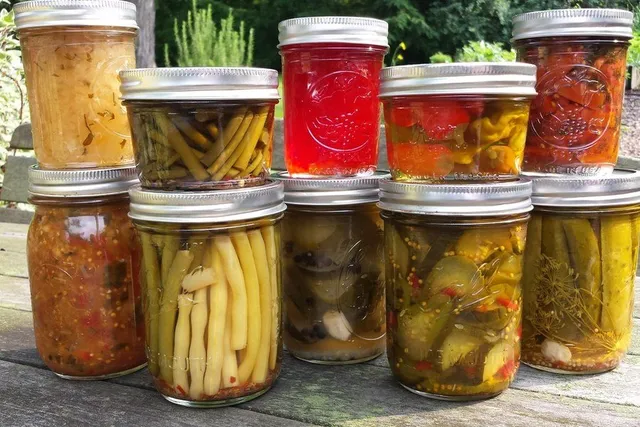Prepare for Pickling

Many pickle recipes are easy enough for even a beginner to be successful.
There are more kinds of pickles than sliced dills, though homemade sliced dills are wonderful. Pickles can be made from most vegetables – asparagus, beets, carrots, snap beans, peppers (sweet, spicy and in-between), green tomatoes, cauliflower, cabbage, cucumbers, summer squash and others. Fruit pickles include apples, pears, figs, red grapes, cantaloupe, and even watermelon rinds. Mixtures of produce are possible. Relishes and chutneys are also, technically, pickled products. Pickles range from sweet to savory. They can be tart or spicy. Pickles can be fermented or quick processed in a boiling water canner or atmospheric steam canner. There are even freezer pickles.
Pickles are wonderful accompaniments to almost any meal. A warm sweet apple relish is a wonderful addition to pork roast or pork chops. Pickled three bean salad enhances a simple sandwich lunch. Think also of pickled products as ingredients. Pickled jalapenos can be added to salsa, chili, and other spicy courses. A few pickled green beans (a.k.a. “dilly beans”) can act as a side dish but they are equally welcome when chopped and added to flavor tuna salad, to add crunch to a pasta salad, or to add brightness to a summer vegetable soup. Try a few dilly beans on a hero sandwich in place of dill spears. They even make a flavorful stirrer for tomato juice based drinks. I prefer to make dilly beans more visually appealing by having both green and yellow snap beans in the same jar.
A successful season starts with preparation. First, discover the pickles you’d like to make. Use only research-based processes and recipes. The National Center for Home Food Preservation is a great resource for pickling processes and lists more than 40 recipes, including some for no-sugar and low-salt diets. So Easy to Preserve is their highly-recommended cookbook. Penn State’s Let’s Preserve series is another source in which to turn. Select recipes that your family will enjoy or that you can give as gifts. Each year I make my family’s favorites but also try at least one new recipe because it might just be my new favorite.
Second, develop a realistic schedule for preserving based on your summer commitments and when the desired produce is in season. I make this list each year so that I do not become overwhelmed and that I also don’t forget to make strawberry jam before that too-short season is over. One of the most important ways to succeed is to use best quality produce at peak ripeness. The sooner from harvest to jar the better the pickle. Therefore, if you don’t grow your own, local farmers markets are a good source of fresh-picked fruits and vegetables.
Third, make a list and purchase the recipes’ ingredients that are shelf stable. Make sure you have enough salt that is specifically for canning and pickling. Sugar may be called for. Fresh spices are a must. I buy distilled water to make brine because my tap water is too hard. Most recipes will call for either white vinegar or cider vinegar. For food safety reasons, it is critical to purchase and use only vinegar that is of 5 percent acidity. An optional item is a calcium chloride product, such as Pickle Crisp, to help firm up the pickles.
Fourth, check your supply of canning jars and lids. Due to supply chain issues and the increased interest in preserving food during the pandemic, the supply of canning jars and lids has not been meeting demand.
By taking the time to prepare now, you will be ready to create wonderful pickles once the produce is in-season and available.
Pickled Dilled Beans
- 2 pounds fresh tender green or yellow beans (5 to 6 inches long)
- 4 heads fresh dill or 4 teaspoons dill seed
- 4 cloves garlic (optional)
- ¼ cup canning or pickling salt
- 2½ cups white vinegar (5 percent)
- 2½ cups water
- 1 teaspoon hot red pepper flakes (optional) or 1 teaspoon cayenne
Yield: About 4 pints
When preparing this recipe, start with clean countertops and utensils. Wash hands with soap and water. Wash whole, fresh produce under cold running water.
Procedure: Wash and trim ends from beans and cut to 4-inch lengths. In each sterile pint jar, place 1 dill head (or teaspoon dill seed) and, if desired, 1 clove of garlic and/or ¼ teaspoon pepper flakes. Place whole beans upright in jars, leaving 1/2-inch headspace. Trim beans to ensure proper fit, if necessary. Combine salt, vinegar and water. Bring to a boil. Add hot solution to beans, leaving 1/2-inch headspace. Adjust lids. Process pint jars in a boiling water bath or an atmospheric steam canner for 5 minutes at altitudes up to 1,000 feet, 10 minutes between 1,001 and 6,000 feet, and 15 minutes above 6,000 feet.
Let beans stand for at least 2 weeks before tasting to allow flavor to develop.
Recipe notes: Garlic and red pepper are optional, but they will give the beans an extra bit of flavor. Use fresh dill when available for the best flavor. When the pickled beans are removed from the canner, the beans may appear shriveled and wrinkled. This is normal because the salt in the pickling solution has drawn moisture out of the bean. As the pickled beans sit in storage, they absorb the pickling solution and plump up again.
Recipe Source: So Easy to Preserve, University of Georgia (2016)
This article was first published by Penn State Extension on May 31, 2022.